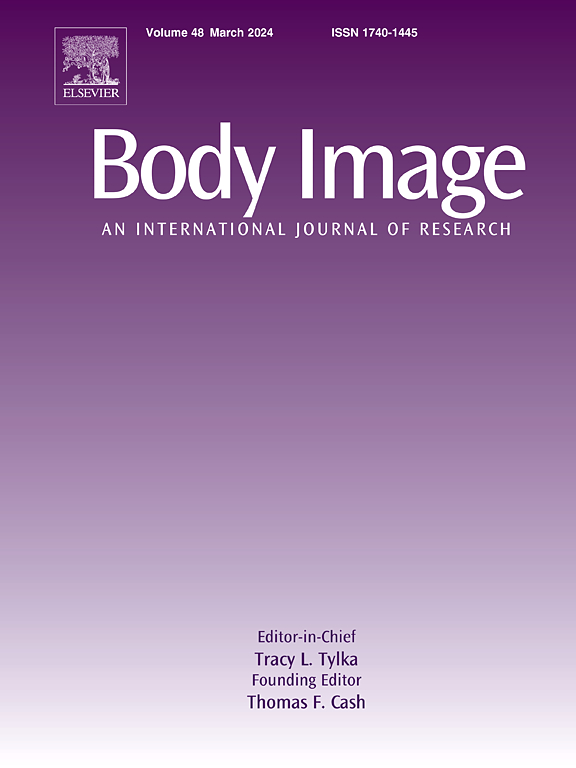中国年轻女性瘦理想内化评价的普通话版心理测量学特征
IF 5.4
1区 心理学
Q1 PSYCHIATRY
引用次数: 0
摘要
在中国年轻女性中,苗条理想的内化与身体形象和饮食失调密切相关。本研究旨在探讨薄理想内化评估(C-THIINA)的中国改编的心理测量学特征。鉴于原始的THIINA (Kidd et al., 2023)包含与行为相关的项目,我们同时探索并比较了完整的C-THIINA和删除行为的C-THIINA的因子结构(C-THIINA- d)。因子分析结果(n = 681)表明,C-THIINA-D的2因子双因子模型与所有测试的备选模型相比具有更好的拟合性。在该模型中,一般因素定义明确,但具体因素定义不明确,支持使用全局因素概念化中国年轻女性的C-THIINA-D。本研究证明C-THIINA-D在中国年轻女性中具有足够的收敛效度、并发效度、内部一致性信度和重测信度。此外,研究结果支持C-THIINA-D相对于社会文化外貌态度问卷-4修订版和最新版理想身材刻板印象量表的内化瘦/低体脂分量表的增量效度和预测效度。研究结果表明,C-THIINA-D是衡量中国年轻女性理想瘦身内化的有效工具。它可以促进中国瘦理想内化的进一步研究,提高对中国女性身体形象和饮食失调的认识。本文章由计算机程序翻译,如有差异,请以英文原文为准。
Psychometric properties of the Mandarin Chinese version of the thin ideal internalization assessment among young Chinese women
The internalization of the thin ideal is closely associated with body image and eating disturbances among young Chinese women. This study aimed to examine the psychometric properties of a Chinese adaptation of the Thin Ideal Internalization Assessment (C-THIINA). Given that the original THIINA (Kidd et al., 2023) includes items related to behaviors, we simultaneously explored and compared the factor structure of the full C-THIINA and the C-THIINA deleting the behaviors (C-THIINA-D). Results of factor analysis (n = 681) showed that the 2-factor bifactor model of the C-THIINA-D had a better fit compared to all alternative models that were tested. In this model, the general factor was well-defined, but the specific factors were not, supporting the use of the global factor to conceptualize the C-THIINA-D for young Chinese women. The present study demonstrated C-THIINA-D has adequate convergent validity, concurrent validity, internal consistency reliability, and test-retest reliability among young Chinese women. Furthermore, results supported incremental validity and predictive validity of the C-THIINA-D relative to the Internalization Thin/Low Body Fat subscale of Sociocultural Attitudes Towards Appearances Questionnaire-4-Revised and the latest version of the Ideal Body Stereotype Scale. Findings suggested the C-THIINA-D is a useful instrument to measure the thin ideal internalization of young Chinese women. It can prompt further study of thin ideal internalization in China and advance knowledge about body image and eating disturbances of Chinese women.
求助全文
通过发布文献求助,成功后即可免费获取论文全文。
去求助
来源期刊

Body Image
Multiple-
CiteScore
8.70
自引率
28.80%
发文量
174
期刊介绍:
Body Image is an international, peer-reviewed journal that publishes high-quality, scientific articles on body image and human physical appearance. Body Image is a multi-faceted concept that refers to persons perceptions and attitudes about their own body, particularly but not exclusively its appearance. The journal invites contributions from a broad range of disciplines-psychological science, other social and behavioral sciences, and medical and health sciences. The journal publishes original research articles, brief research reports, theoretical and review papers, and science-based practitioner reports of interest. Dissertation abstracts are also published online, and the journal gives an annual award for the best doctoral dissertation in this field.
 求助内容:
求助内容: 应助结果提醒方式:
应助结果提醒方式:


